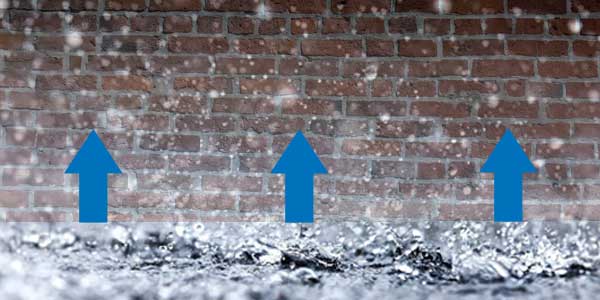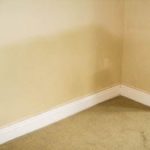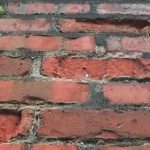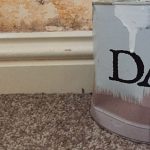The DIY Fix is reader supported. When you buy after clicking a link on our site, we may earn an affiliate commission.
Rising damp is less common than other forms of damp, such as penetrating damp and condensation. It is caused when water is drawn from the ground via capillary action. This is when water travels through the pores and capillaries in your building materials, such as the brickwork and mortar.
Once the water has traveled through the brickwork, it is usually first noticed internally. This appears as damage on internal walls. Visible damage will usually be noticed from floor level up to around 1.2m. This is the point where gravity will stop capillary action from allowing water to travel any higher.
Damage on internal walls, is usually in the form of damp tidemarks and other unsightly defects, such as blistering plaster and paint.

You may also find damage to your woodwork, such as your skirting boards and even the floor joists. If left untreated, this can potentially lead to serious problems such as wood rot.
What is rising damp caused by?
As we mentioned, rising damp is caused when ground water travels up through the building materials of your property.
This capillary action is usually stopped by a damp proof course. A damp proof course can be found at around 150mm above the external ground level of your property.
The damp proof course (DPC) Is intended to block the moisture that is rising through capillary action. It should stop moisture before it reaches high enough to cause internal damage. This is usually slightly above the external ground level and below the floor level inside the property.
If your damp proof course is working correctly, this should mean the water is blocked at this point and can’t travel any further.
DPC’s are made of different materials, depending on the period of your property. in older properties, you will often find materials such as slate were used.
In even older properties, you may find that there is no DPC present at all.
Finally, in modern properties it is more common to see materials such as bitumen, or a plastic damp proof course. You will usually be able to see this on external walls roughly 150mm above ground level.
The most common reasons for rising damp, are either that you have no DPC, or the existing DPC has failed. This means there is no longer an effective barrier to stop capillary action drawing water from the ground.
Other potential causes of rising damp
Even though a missing, or damaged DPC are the most common cause of rising damp. This does not mean they are the only cause.
Another potential issue is bridging. This is where water can find its way around a working damp proof course. Below are a few examples of how bridging can occur:
- Outside ground level is higher than internal floor level. In this scenario, ground water can bridge above the damp proof course.
The solution to this will depend on individual circumstances of the property. One option is to lower the outside ground level entirely or create a trench. Another would be to tank the inside of the property above the external ground level. This could even be combined with a new DPC just below the internal tanking. - Internal bridging through a concrete floor. An example of this is internal plaster in contact with a concrete floor. This concrete floor could then be in contact with the wall below the DPC.
Here water would bridge from the wall below the DPC into the concrete floor. Following this, it would travel up through the concrete via capillary action. Once high enough, this would soak into the plaster on your internal walls. - Cavity bridging. In this scenario, the water would be able to travel through the cavity, from below the DPC. This is usually a result of rubbish and debris in the cavity.
Water would soak into the debris below the DPC. Then it would travel up and bridge back in. This would happen once the water has reached above the damp proof course.
As you can see there are several ways that water can travel up and cause rising damp. For example, if bridging is your issue, then fixing or replacing your DPC will do little to address the problem.
Therefore, diagnosis is very important. If you are unsure, it is recommended to get a professional in, such as an independent damp surveyor.
How is rising damp treated?
If bridging is the issue
Rising damp can be treated in several different ways. The treatment will depend on the cause of the problem.
If bridging is the issue, you won’t need to touch your damp proof course. Instead, you will need to stop the bridging.
For example, if you have identified debris in your cavity, there is a good chance this is the cause of rising damp. This will be causing water to bridge from below your DPC and up into your internal walls. This can be easily fixed by simply cleaning the cavity.
To clean the cavity, you will need to remove one or two bricks from the affected area. Then scrape out the debris and rubbish that is blocking the cavity gap. Obviously, if this is something you are not confident with, you will need to hire a professional.
Once the cavity is cleared of all debris, this should completely stop water from bridging past the DPC and into the property.
If on the other hand, you had a situation where water is travelling up through an internal concrete floor. One option here, could be to excavate to the DPC level. Once you reach this point, you could apply a liquid damp proof membrane and then refill with concrete. This would create a barrier and stop damp from rising through the concrete.
These are just a couple of examples. We also mentioned how to address high external ground level previously. This involved lowering external ground level (possibly by digging a trench). As well as applying tanking internally.
There are many ways that water could be bridging. Unfortunately, without some expert knowledge, these issues can easily be missed. Especially if you don’t know what you’re looking for.
Therefore, hiring a professional damp surveyor can be a good idea. Once they identify your issue, you can then decide if you go down the DIY route or hire a professional.
If your DPC is the issue
If your damp proof course is the issue, you have a few options.
- You can add a chemical DPC injection. This is the easiest option, as it is relatively simple and low cost.
To install a chemical DPC you will need to drill holes in your bricks mortar. Once the holes are drilled you inject a damp proof cream.
The chemical DPC will enter the same pores and capillaries that water would travel through. This forms a waterproof barrier. - Your second option is to reinstall a physical damp proof course. This is far more complicated and will involve removing bricks and replacing the original DPC.
Usually, this will require a professional builder, as it is making structural alterations. You can see a good example video of this process below:
Rising damp treatment cost DIY
If you intend to treat rising damp yourself, the price will usually be quite low.
For example, if you have identified a bridge in your cavity. This will involve removing one or two bricks to clear the debris. For this type of job, the price is probably going to be under £50. This can be achieved with a couple of chisels, a hammer, a bag of sand and cement and a trowel.
However, bridging is less common, and it is more likely that you will be adding a new DPC. Your best option is a chemical DPC, as this is the easiest and most affordable.
The cost of adding a chemical DPC yourself, is usually going to cost about £10 – £15 per meter. Bear in mind, if you have a cavity wall you will need to inject both the internal, and external skins.
A market leader in this type of DPC injection is Dryzone. You can see a kit they offer on Amazon by clicking here you can also read other customer reviews
Rising damp treatment cost professional
If you decide to hire a professional, you can expect the price to rise quite a bit. However, you will have the peace of mind that the job has been done correctly.
In our experience, professional damp proof injection tends to cost around £70 per meter.
If you want a physical damp proof course installing, this will usually be slightly more expensive.
The materials for a physical DPC do tend to be cheaper. However, there will be increased labour costs. This is due to the work being more technical and time consuming.
For prices relating to bridging issues. This can vary quite significantly. Every job will be unique. So, this will usually be priced on a per job basis. You should also factor in any damp survey costs that are required to find the issues.
Conclusion
As you can see, rising damp is not always a simple problem to identify. There are several possible causes.
To permanently fix rising damp, you need to make sure you have identified the correct issue.
Adding or repairing a DPC is the most common solution to rising damp. However, if the damp is caused by other problems, such as bridging, then a new DPC won’t fix it.
The key takeaway here, is to make sure you identify the cause of your rising damp. If you get this right, your damp issues can be addressed and fixed correctly. But if you get it wrong, the problem will remain, and you will end up spending more money trying to fix it.




